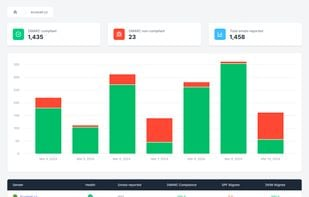Feature set
DMARCEye focuses almost exclusively on DMARC reporting and monitoring, providing a robust suite of tools for in-depth analysis. We found its AI-powered report analysis particularly useful for quickly identifying issues and understanding complex DMARC data. It's built to simplify the often-intimidating world of DMARC.
The platform offers solid features like source detection, forward detection, and spoof detection, which are core to managing DMARC effectively. While it excels in its niche, its feature set is tightly scoped around DMARC, meaning it doesn't venture into broader email marketing or relay services.
ReachMail, on the other hand, integrates DMARC management and reporting as part of a much broader email marketing and relay service. Its DMARC capabilities are designed to protect brands and maximize email delivery within its larger ecosystem, which includes list cleaning, automation, and campaign management.
While it provides essential DMARC reporting, it's not as specialized or granular as DMARCEye. We observed that its DMARC features are geared towards users who need DMARC as one component of a comprehensive email strategy, rather than a standalone, deep-dive DMARC solution.











































 4.5 / 5(1)
4.5 / 5(1)
 0 / 5(0)
0 / 5(0)



